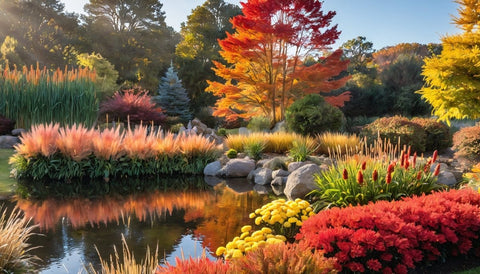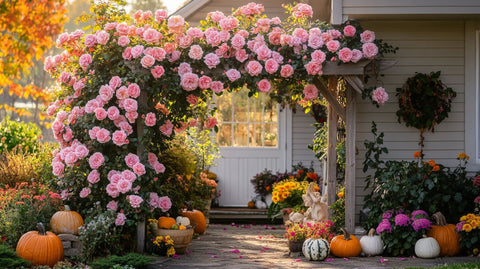The Allure of Fall Gardening
There’s something truly magical about fall gardens. With its vibrant palette of warm hues, crisp air, and the promise of seasonal harvests, fall is the perfect time to revamp your outdoor space. One standout feature you might consider incorporating into your garden is the ornamental cattail. These unique plants aren’t just for marshy wetlands anymore—cattails can transform your landscape into a stunning fall escape!
Understanding Ornamental Cattails: Nature's Sculptures
Physical Characteristics and Varieties

Ornamental cattails are visually striking with their tall, graceful stems and soft, fluffy seed heads. You’ll typically find them soaring six to twelve feet tall, depending on the variety. Popular choices among gardeners include Typha latifolia (common cattail) and its smaller brethren like Typha angustifolia. Each variety brings a unique aesthetic that can complement various garden styles.
Benefits of Cattails in Landscaping
Why choose cattails, you ask? Well, aside from their dramatic appearance, these plants provide valuable ecosystem benefits. They create habitats for frogs, birds, and beneficial insects, and they play a crucial role in water filtration and erosion control. When strategically placed, cattails can breathe life into any garden, while also lending a hand to the environment!
Planning Your Fall Garden: Getting Ready
Assess Your Garden Space
Before you dive in, take a good look at your garden’s layout. Are there sunny spots that could use a pop of greenery? Cattails thrive best in areas that get plenty of sun and have moist soil. Choose a location that complements your existing flora, blending beautifully with perennials and ornamental grasses.
Choosing the Right Variety of Cattails
Not all cattails are created equal! Consider the space you have: do you need a towering plant to make a statement, or something smaller for a delicate touch? Native species tend to be hardier, so weigh your options based on your garden’s specific conditions.

Preparing the Planting Area: Laying the Groundwork
Soil Preparation
Your cattails will flourish in rich, well-aerated soil. Before planting, test the soil pH and amend it as necessary. Adding organic matter like compost can improve soil structure and nutrient levels, laying the perfect groundwork for your cattails.
Choosing the Ideal Location
Location is everything! Ensure your cattails will be near water features such as ponds or streams—this helps them thrive. Pair them with complementary plants like Calamagrostis (feather reed grass) or other fall-flowering perennials for a stunning visual effect.
Planting Ornamental Cattails: Timing and Techniques
When to Plant for Maximum Impact
If you're aiming for a fall display, early fall is the ideal time to plant cattails. This allows them to establish roots before winter sets in, preparing them for a robust spring growth spurt.
Step-by-Step Planting Guide
Ready to plant? Here’s a simple guide:
- Dig Holes: Create holes large enough to accommodate the root ball. Spacing should be about 1 to 2 feet apart, depending on the variety.
- Placement: Position the root ball so the top is level with the surrounding soil to prevent waterlogging.
- Water: After planting, give them a good drink and ensure the soil stays moist as they settle in.

Maintaining Your Fall Garden with Cattails: Tips for Success
Seasonal Care Tips
Keep an eye on watering during dry spells, as cattails love moisture. A bi-annual fertilization in spring and summer can support healthy growth. Just use a balanced fertilizer and follow the package instructions.
Pest and Disease Management
While cattails are generally low maintenance, keep an eye out for potential pests like aphids. A gentle spray of water can often dislodge them, and if necessary, organic insecticidal soap is a safe option.
Pruning and Dividing Cattails
Every couple of years, consider dividing your cattails to promote growth and prevent overcrowding. In late winter or early spring, dig them up, separate them, and replant. They’ll thank you with a lush display!
Highlighting Fall Aesthetics in Your Garden
Combining Cattails with Other Fall Plants
The beauty of ornamental cattails shines even brighter when paired with other fall elements. Consider poppies, asters, or even ornamental pumpkins to create a stunning visual feast. Add subtle decorations for a charming seasonal vibe!
Creating Focal Points
Use cattails as beautiful focal points to guide the eye throughout your garden. Group them in clusters to create a lush, green haven that draws attention and admiration.
Wrapping It Up
Incorporating ornamental cattails into your fall garden isn’t just about beautification; it’s about creating harmony with nature. With their effortless grace and practical benefits, they can transform your outdoor space into a vibrant sanctuary. So why not take the plunge? Give cattails a chance, and you might just discover a new gardening passion!

Join the Gardening Conversation!
If you enjoyed exploring the world of ornamental cattails, subscribe to the blog for more insightful gardening tips and tricks. Share your fall garden journey on social media, and connect with local gardening communities to enrich your experience.
Additional Resources
Looking for more information? Check out these resources:
- Cattail Care Guide
- Fall Gardening Journal
- Visit local nurseries for the best selection of ornamental cattails and gardening supplies!






























Comments (0)
There are no comments for this article. Be the first one to leave a message!